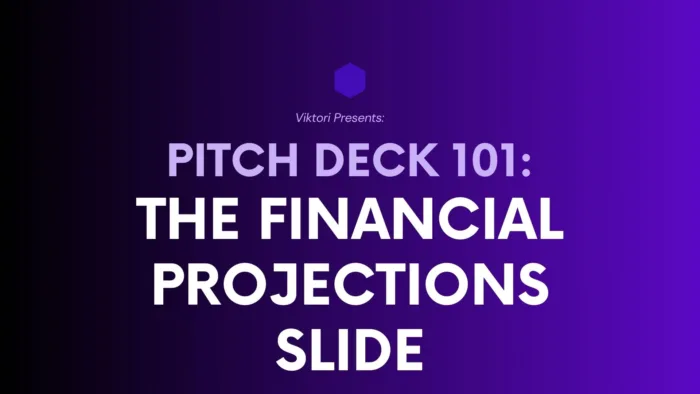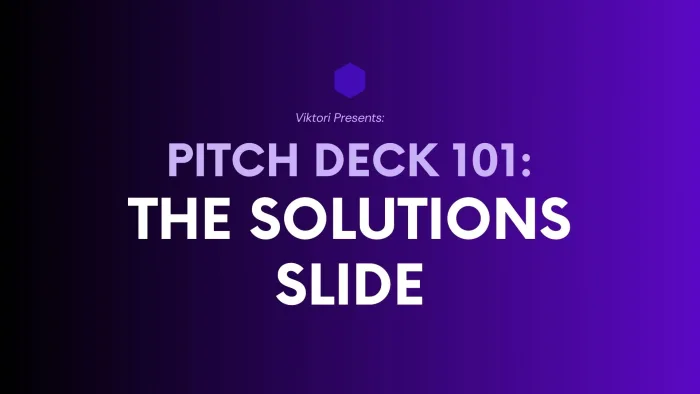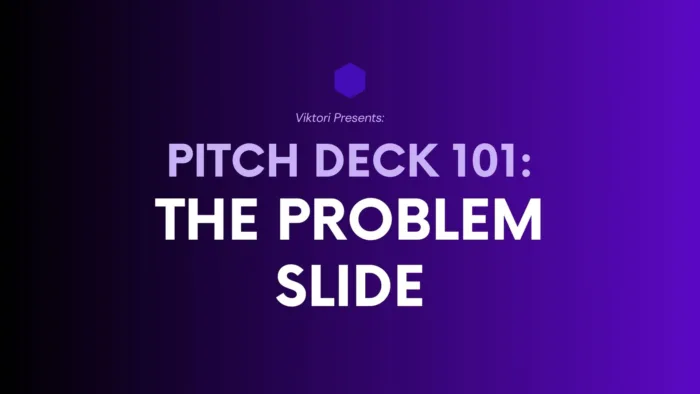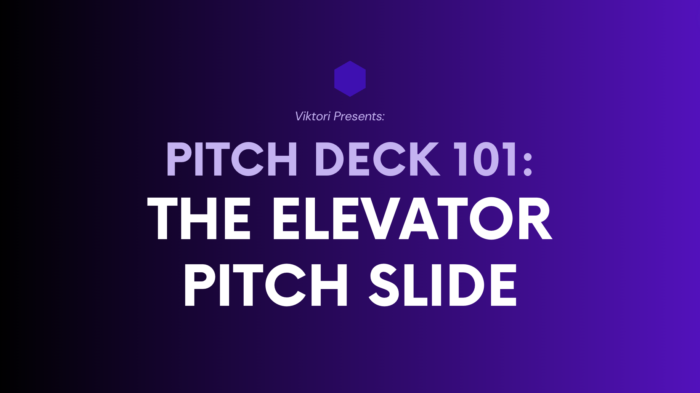You’ve got this incredible idea for a utilities startup—maybe it’s revolutionizing solar energy, fixing inefficiencies in water management, or turning waste into clean energy. But here’s the kicker: no one’s biting. Investors give polite smiles, nod a bit too much, and you’re left wondering what went wrong. Spoiler alert: It’s your pitch deck.
I’m Viktor, a pitch deck expert and creative business strategist. Over the past 13 years, I’ve helped businesses secure millions of $ in funding thanks to my approach and I’m sharing it here in this pitch deck guide.
I get it—utilities aren’t exactly “sexy.” But I’ve cracked the code to make even the driest industry pitch electrifying (pun intended). Let’s skip the fluff and dive straight into building a pitch deck that’ll have investors flipping out—in a good way.
Get My 12 Slide Framework That Got $500mil in Funding For Clients.
What do you think of having 12 dead simple formulas, that will help you craft 12 slides, in about 1 hour? That’s what you’ll get, when you download my 12 slide framework. Save hours crafting your pitch deck copy with my tested approach that includes:
- Elevator pitch one sentence formula
- Problem/ solution slide one sentence formula
- Competitor slide one sentence formula
- 9 other formulas, tips, tricks and advice
The formulas worked for 40+ industries and 500+ companies. Including the one you’re looking at now.
Clicking the link won’t charge you anything.
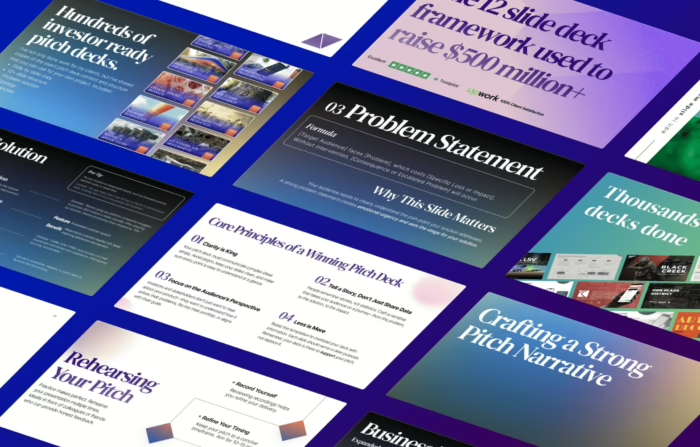
Get an investor ready pitch deck that gets you funded and saves over 30 hours of your time.
Join 100s of successful entrepreneurs who’ve transformed their pitch decks by using my hands-off approach, which includes: market research, copy, design, financials, narrative and strategy.
1 week turnaround time and less. Special pricing for early stage companies.
The least you will get on this call is 10 actionable tips & strategies to own that next pitch, worth $599, for free.
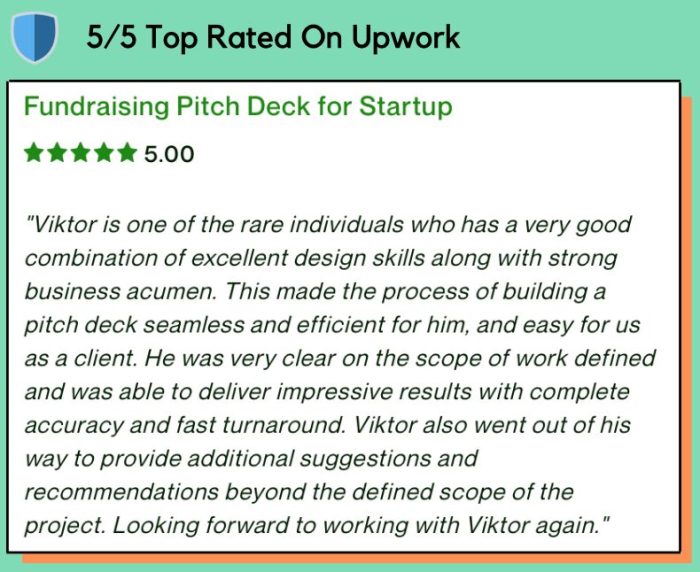
16 Slide Utilities Pitch Deck Template | Google Slides
The above is is just a simplified pitch deck version developed as part of our entrepreneurship program for graduate studies.
Founders that are serious about getting the funding they need, opt in for a deck has industry specific content, superb narrative and award winning design like these ones below:









I can help you build that deck with my hands-off process in 7 days or less.
Book a free 30 minute call below if you’re serious about getting an investor ready deck, and we’ll discuss your needs in detail. I’ll help you design the deck, write the content, develop the narrative and flesh out the strategy with financials.

We help 15,000+ founders every month create better pitch decks.
Alternatively, get the custom template for just $69,99.As soon as the payment is processed I’ll send over a quick questionnaire and deliver the deck in 24 hours and less.

Follow us on social for the newest templates:
Slide 1: Cover Slide
- Startup Name/Logo: Place your startup’s name and logo prominently at the top or center of the slide to ensure it’s the first thing viewers notice.
- Tagline or Brief Description: Include a concise, impactful tagline or a brief description that captures the essence of your startup. Example: “Empowering the Future of Energy with Smart Grid Technology.”
- Presenter’s Name and Contact Information: Your name, title, and contact details (email and phone number) should be at the bottom, making it easy for investors to follow up.
Slide 2: Introduction
- Brief Overview of the Company: Start with a compelling introduction that hooks the audience. Example: “At [Startup Name], we’re harnessing cutting-edge technology to revolutionize how energy is distributed and consumed, making it more efficient, reliable, and sustainable.”
- Mission Statement: Clearly state your mission. Example: “Our mission is to innovate the utilities sector by integrating smart grid technology, reducing waste, and promoting sustainable energy usage.”
- The Problem You’re Solving: Introduce the problem in a way that resonates with the audience. Example: “Despite advancements in renewable energy, the current grid system faces inefficiencies that lead to energy waste and increased costs for consumers.”
Slide 3: The Problem
- Detailed Description of the Problem: Delve into the specifics of the problem. Use data and visuals to highlight inefficiencies, gaps, or challenges in the utilities sector. Example: “The U.S. grid loses approximately 6% of its electricity through transmission and distribution inefficiencies.”
- Current Gaps or Inefficiencies: Identify where the market is lacking. Example: “Existing grid infrastructures are outdated and not equipped to handle the variability and decentralization of renewable energy sources.”
- Impact of the Problem: Discuss the broader impact, including environmental, economic, and social aspects. Example: “This not only leads to higher energy costs for consumers but also impedes our progress towards a sustainable energy future.”
Slide 4: The Solution
- Overview of Your Product/Service: Introduce your solution succinctly. Example: “[Startup Name]’s smart grid technology utilizes real-time data analytics and AI to optimize energy distribution, reducing waste and lowering costs.”
- Key Features and Benefits: Highlight 3-4 key features and their direct benefits. Use bullet points for clarity. Example:
- “Dynamic Load Balancing: Reduces energy waste and improves grid resilience.”
- “Renewable Energy Integration: Facilitates a higher penetration of renewable sources into the grid.”
- “Consumer Empowerment: Provides consumers with real-time energy usage data, encouraging informed consumption and energy savings.”
- How It Addresses the Problem Effectively: Tie the features back to how they solve the identified problem. Example: “By modernizing the grid with our technology, we can address the inefficiencies head-on, paving the way for a more sustainable and cost-effective energy future.”
These initial slides set the stage for your utilities pitch deck, capturing the audience’s attention by clearly defining the problem your startup addresses and presenting your innovative solution.
Continuing from the introduction and problem-solution slides, let’s detail the next four slides of the utilities pitch deck, focusing on technology, market analysis, business model, and go-to-market strategy.
Slide 5: Technology and Innovation
- Description of the Technology: “At the core of our solution is a proprietary AI algorithm that predicts energy demand spikes and optimally redistributes energy resources in real-time, minimizing waste and maximizing efficiency.”
- Proprietary Technology or Innovation: Highlight any patents or unique technological advantages. Example: “Our technology is protected by two patents and represents the first scalable solution of its kind to integrate seamlessly with existing grid infrastructures.”
- R&D and Technical Advantages: Briefly mention ongoing research and development efforts and how they will continue to keep your solution at the cutting edge. Example: “We’re committed to continuous innovation, with 15% of our annual budget dedicated to R&D, ensuring our technology evolves with the latest advancements in AI and machine learning.”
Slide 6: Market Analysis
- Size and Growth of the Target Market: “The global market for smart grid technology is expected to reach $60 billion by 2025, growing at a CAGR of 20%.”
- Market Trends and Drivers: Discuss trends that are favorable to your business. Example: “Increasing adoption of renewable energy sources and governmental regulations pushing for energy efficiency are major drivers behind the growing demand for smart grid solutions.”
- Competitive Landscape and Your Positioning: “While several players exist in the smart grid space, our solution’s unique ability to predict and adapt to energy demand in real-time sets us apart, addressing a critical need that is currently unmet in the market.”
Slide 7: Business Model
- Revenue Model: “Our revenue model combines a subscription-based service for utility companies with a tiered pricing structure based on grid size and energy savings achieved.”
- Pricing Strategy: “We offer competitive pricing that allows utilities to see ROI within the first year of implementation, encouraging adoption and scaling.”
- Sales and Distribution Channels: “We leverage direct sales to utility companies, supplemented by strategic partnerships with renewable energy providers and government agencies to broaden our market reach.”
- Partnerships and Collaborations: “Key partnerships with industry leaders like X-Energy and governmental bodies will expedite our go-to-market strategy and reinforce our position as a trusted solution provider.”
Slide 8: Go-to-Market Strategy
- Marketing and Sales Strategy: “Our marketing strategy focuses on demonstrating cost savings and efficiency improvements through targeted campaigns, industry conferences, and whitepapers. Sales efforts will initially concentrate on regions with high renewable energy adoption, expanding as regulatory environments evolve.”
- Customer Acquisition and Retention Plans: “We plan to acquire customers through a mix of inbound marketing, outbound sales, and by showcasing successful pilot programs. Customer retention will be supported by exceptional ongoing technical support and regular software updates that provide additional value.”
- Timeline for Market Entry and Scaling: “Market entry is planned for Q2 2024, starting with pilot projects in California and Texas, states leading in renewable energy usage. Scaling nationally and internationally will follow regulatory approval milestones and strategic partner expansions.”
These slides delve into the specifics of how your utility startup stands out technologically, the market dynamics at play, the underlying business model that ensures sustainability and growth, and a strategic approach to capturing and expanding your market share.
Continuing with the development of a comprehensive utilities pitch deck, let’s detail slides on regulatory environment, sustainability and ESG impact, financial projections, and the team.
Hold on. You might want to check my list on the best presentation and communication books...
These are crucial books that will help you improve the design and structure of your decks and presentations, besides improving your delivery and skyrocketing your confidence when facing investors. Check them out below.
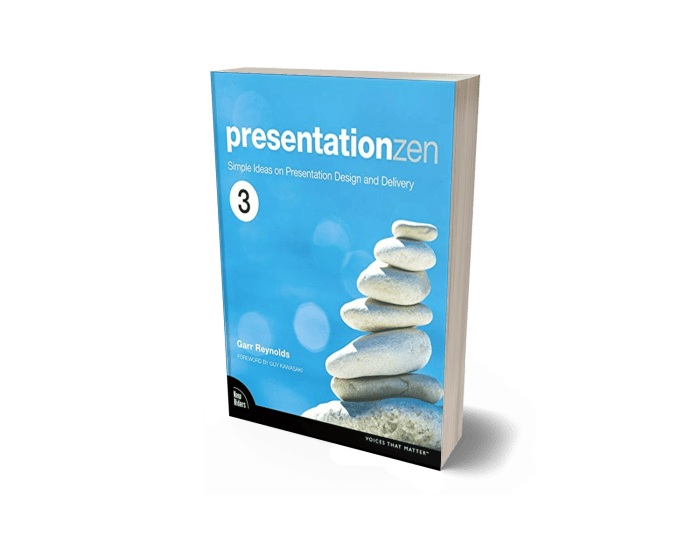
Slide 9: Regulatory Environment
- Overview of Relevant Regulations: “Our technology aligns with the latest regulatory requirements for energy distribution and efficiency, including the Clean Energy Standard Act and the Grid Modernization Initiative.”
- Strategies for Navigating the Regulatory Landscape: “We have a dedicated regulatory affairs team that actively engages with policymakers and regulatory bodies to ensure compliance and to advocate for favorable policies.”
- Regulatory Approvals or Pending Applications: “Currently, we are in the process of obtaining approval from the Federal Energy Regulatory Commission (FERC), which will significantly enhance our marketability and operational scope.”
Slide 10: Sustainability and ESG Impact
- Environmental Benefits: “Our smart grid solution is projected to reduce carbon emissions by 30% in serviced areas, by optimizing energy distribution and reducing reliance on non-renewable sources.”
- Social Impact: “By improving grid efficiency and reliability, we also contribute to societal well-being, ensuring that communities have access to affordable and uninterrupted power.”
- Governance Practices: “Our governance framework emphasizes transparency, ethical business practices, and stakeholder engagement, ensuring we meet the highest standards of corporate responsibility.”
Slide 11: Financial Projections
- Revenue Projections: “With conservative market penetration, we project revenues of $10M in the first year post-launch, growing to $50M by year three as we expand our services and customer base.”
- Key Financial Metrics: “Our financial model forecasts a break-even point within the first 18 months, with a projected EBITDA margin of 25% by the third year.”
- Funding Requirements and Use of Funds: “We are seeking $20M in Series A funding to finalize technology development, secure regulatory approvals, and launch our go-to-market strategy. The investment will also support initial operational costs and scaling.”
Slide 12: The Team
- Profiles of Key Team Members: “Our leadership team comprises veterans from the utilities sector, software development, and regulatory compliance. For instance, our CEO, Dr. Jane Doe, brings 20 years of experience in renewable energy projects.”
- Relevant Experience and Expertise: “Each team member has been chosen for their unique skills and proven track record in their respective fields, ensuring we have a well-rounded and capable team to drive our project.”
- Advisory Board or Industry Partners: “We are supported by an advisory board that includes influential figures in energy policy, technology innovation, and business strategy, providing us with invaluable insights and networks.”
These slides offer a deeper dive into how the startup navigates the complexities of the regulatory environment, its commitment to sustainability and ethical governance, and the solid financial grounding of the business model. Highlighting the experienced and skilled team underscores the startup’s capability to execute its vision, making a compelling case for investment.
Completing the utilities pitch deck, let’s focus on detailing the last four slides: Traction and Milestones, Funding Ask, Risk Analysis and Mitigation, and the Closing slide.
Slide 13: Traction and Milestones
- Key Achievements to Date: “Since our inception, we’ve successfully completed three pilot projects with local utilities in California, demonstrating a 20% increase in grid efficiency and a 15% reduction in operational costs.”
- Current Customers or Pilot Projects: “Our technology is currently being tested in a year-long pilot with the City of San Jose, aiming to integrate renewable energy sources into their municipal grid.”
- Awards, Recognitions, or Media Mentions: “Recognized as ‘Innovator of the Year’ by the National Renewable Energy Association in 2023, our solution has been featured in major publications including Forbes and TechCrunch.”
Slide 14: Funding Ask
- Amount of Funding Sought: “We are seeking $20 million in Series A funding to accelerate our technology development, expand our team, and launch our solution in key markets.”
- Terms and Equity Offered: “Offering 15% equity, we’re looking for strategic partners who can bring not only capital but also industry insights and networks.”
- Future Funding Rounds Planned: “Anticipating a Series B round in late 2025, aiming to further scale our operations internationally.”
- Use of Funds: “Funds will be allocated towards R&D (30%), marketing and sales efforts (25%), operational expenses (20%), and regulatory compliance (25%).”
Slide 15: Risk Analysis and Mitigation
- Key Risks and Challenges: “Identified risks include regulatory changes, technological advancements by competitors, and initial market adoption rates.”
- Strategies for Risk Mitigation: “We plan to mitigate these risks through continuous innovation, active regulatory engagement, and targeted marketing strategies to early adopters in the utilities sector.”
- Contingency Plans: “Our contingency measures include a flexible business model that can adapt to regulatory changes, and a strong IP portfolio that protects our technological advancements.”
Slide 16: Closing Slide
- Summary of Key Points: “To summarize, [Startup Name] offers a groundbreaking smart grid technology that promises to revolutionize the utilities sector by enhancing efficiency, integrating renewable energy, and reducing operational costs.”
- Call to Action: “Join us in leading the charge towards a more sustainable and efficient energy future. We’re seeking strategic partners who are as passionate about innovation in the utilities sector as we are.”
- Thank You and Contact Information: “Thank you for considering [Startup Name]. For further discussion or to schedule a deeper dive, please contact us at [Contact Information]. Let’s power the future, together.”
This comprehensive outline and detailed content for each slide ensure that the utilities pitch deck is not only informative and compelling but also structured in a way that logically flows from introducing the problem to presenting the solution, demonstrating traction, and making a strong case for investment. The final slides reinforce the startup’s potential and readiness for scaling, inviting investors to be part of a promising journey in the utilities sector.
Last Words
So there you have it—a utilities pitch deck that actually works. No jargon, no overstuffed slides, just a streamlined, compelling case for why your startup is the next big thing in utilities.
Remember, investors don’t want a thesis; they want clarity, impact, and a reason to believe you’ve got this. Nail those slides, keep it simple, and don’t be afraid to let your passion shine through. Because, let’s be honest, if you’re not excited about your own idea, why should they be?
And hey, if this guide saved you from creating a PowerPoint nightmare or helped you get one step closer to funding, you’re welcome. Now go light up that room (or Zoom call)—the utilities world needs your big idea.
You got this!
But if you don’t got it:
Join hundreds of successful entrepreneurs who’ve transformed their pitch decks with my help.
Let me develop an investor ready deck by using my hands-off approach, which includes: market research, copy, design, financials, narrative and strategy.
One week turnaround time.
The least you will get is 10 actionable tips & strategies to own that next presentation, worth $599, for free.

If you want to really dive into the world of pitch decks, check out our complete collection of pitch deck templates.
Check out some of the essential 101 guides:
Mastering the Financial Projections Slide: Turning First Impressions into Lasting Opportunities
You’re convinced your startup is the next big thing, but somehow, your pitch keeps landing…
Creating an Impactful Traction Slide for Your Investor Pitch Deck: A Startup Guide
You’ve got the next unicorn startup brewing, but here’s the harsh reality: your traction slide…
Mastering the Pitch Deck Solution Slide
You’ve got the next big thing, whether it’s a revolutionary SaaS platform or the future…
Mastering Your Pitch Deck Go-to-Market Slide: A Step-by-Step Guide For Startups
Ever pitched your groundbreaking idea, only to be met with blank stares and polite nods?…
Pitch Deck Problem Slide: Template, Examples, Guide
You’ve got a groundbreaking business idea, but somehow, the investors aren’t biting. Here’s the kicker:…
The Elevator Pitch Slide | Examples, Template, Tips & Guide
Imagine having a revolutionary idea that could disrupt an entire industry. You’ve done the hard…

